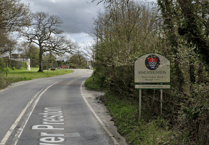A 500kg bomb discovered in the back garden of a residential property in Plymouth, which prompted one of the largest evacuation operations since the end of the Second World War, was safely removed by bomb disposal experts from the British Army and Royal Navy on Friday, February 23.

Around 30 of the Armed Forces’ most experienced bomb disposal specialists worked around the clock since Tuesday, February 20 to assess the condition of the bomb – before it was successfully removed from a densely populated residential area, and towed out to sea, where it was detonated in the next 24 hours.
The munition, identified as an air-dropped German bomb from World War Two – designated SC-500 – was assessed as posing a significant risk to public safety, prompting the evacuation of residents within a radius of approximately 300 metres.

Plymouth City Council, with support from Devon and Somerset Fire and Rescue Service, Devon and Cornwall Police, and members of the Armed Forces, led a major operation to safely evacuate more than 10,000 residents from the vicinity of where the bomb was found, then from the surrounding area of the route it was transported along before it was taken to sea.
Defence Secretary Grant Shapps said: “I would like to express my thanks to all our personnel involved in this highly complex operation, who worked both night and day this week to keep the public safe and minimise the risk of damage, as well as the public for their patience and cooperation.
“The success of this operation is testament to the level of skill and expertise across our Armed Forces, as well as the bravery and fortitude of our personnel when faced with high-risk situations and working under extreme pressure.”
The complex disposal operation required hours of careful analysis by Explosive Ordnance Disposal (EOD) experts from both the Army and Navy, supported by specialist scientific advice from the Defence Science and Technology Laboratory, to establish the condition of both the explosive payload contained within the bomb – and the status of its fuze – before further action could be taken.
If the fuze or the explosive payload had significantly degraded, it may not have been possible to move the bomb and there would have been a significant risk of an uncontrolled explosion – with several residential houses within the projected blast radius.
After careful assessment, it was decided that moving the bomb would present a lower risk to the residential area – and it was transported in a convoy to a slipway near the HMNB Devonport base, before being towed behind a Navy vessel and submerged to a safe depth at sea.”
Royal Navy divers planted an explosive charge on the bomb to complete the disposal operation.
The disposal team was comprised of members of the Army’s 11 EOD and Search Regiment, who are often the first responders from the Armed Forces when called upon by local authorities to assist with disposal of unexploded munitions.
They were supported by elements from 35 Engineer Regiment (EOD and S) who provide vital mitigation measures around the immediate location of the munition, and 42 Engineer Regiment (Geographic). The team was further supported by members of the Royal Navy’s Diving and Threat Exploitation Group, based nearby at Plymouth’s HMNB Devonport.
More than 80 further Navy personnel from HMNB Devonport provided support to the Council and emergency services, after acceptance of a Military Aid to Civilian Authorities (MACA) request to the MOD.
The actions carried out as part of the operation prompted the first ever use of the Government’s Emergency Alert system in a non-test context.
Residents in Plymouth received an update to their mobile telephones warning them of the transportation of the bomb to the Torpoint Ferry slipway, along with an estimated timeframe for the movement.
The system is activated in instances that may present a risk to life, where essential information can help keep the public safe.
Plymouth City Council said: “We would like to say a big thank you for the patience of all those who were evacuated from their homes in Keyham while the unexploded wartime bomb was made safe.
“The bomb was moved from St Michael Avenue by bomb disposal experts from the Royal Navy and Army and taken to the Torpoint Ferry slipway. It was then towed out to sea for disposal.
“Roads have now been re-opened and it is safe for residents to return home.”





Comments
This article has no comments yet. Be the first to leave a comment.